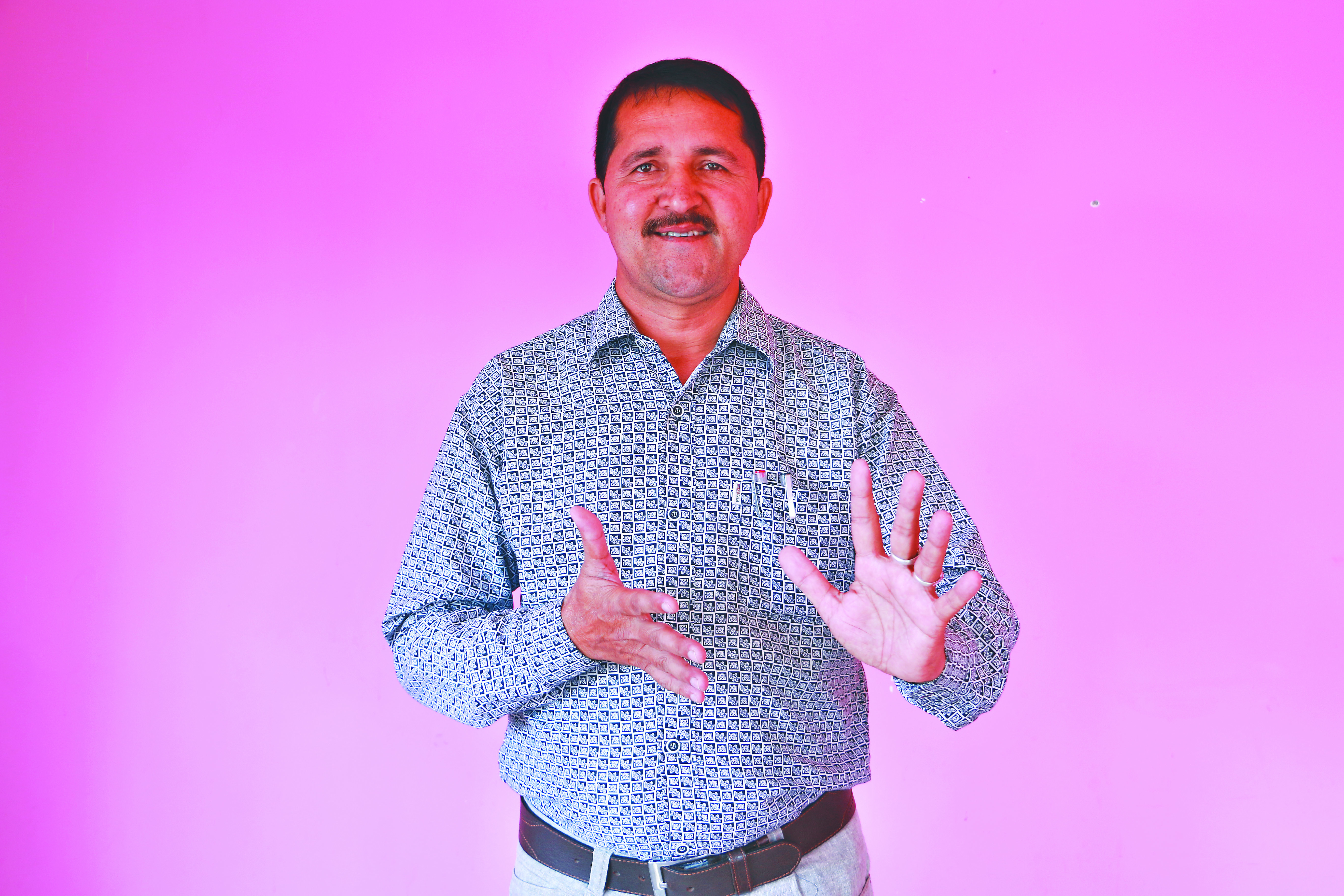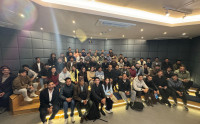Culture & Lifestyle
This teacher is making Nepali Sign Language accessible to all
A sign language teacher for 21 years, Hari Prasad Adhikari, has been actively making videos on Nepali Sign Language on YouTube for the last five years.
Ankit Khadgi
Every week, Hari Prasad Adhikari brainstorms content ideas and topics for his YouTube channel. Once he gets an idea that he likes and feels will make helpful content, he sits in front of a camera and starts recording. What sets Adhikari's YouTube channel apart from many other channels on the platform is that his channel is dedicated to teaching Nepali Sign Language.
Ever since Adhikari created his YouTube channel, Nepali Sign Language, five years ago, he has been uploading a new video every Saturday, hoping that his efforts will help at least someone who wants to learn sign language. His son helps him with the technical aspect of making and uploading videos on the platform.
"Knowing that someone out there is watching my videos and learning sign languages makes me immensely happy," says Adhikari, who is also a sign language teacher.
Developed in 1998, the Nepali Sign Language is used by people with hearing disabilities and sign language instructors in schools and various other institutions in the country. For the Nepali deaf community, it's the medium through which they communicate with themselves, their families and friends.
According to the National Federation of Deaf Nepal, 22 schools teach sign language under special education programmes in Nepal. In communities that have no deaf schools, the government operates 174 'resource classes', which focus on teaching sign language to groups of students.
However, many say the quality of teaching in these schools is not up to the mark, and many students with hearing disabilities enrolled at various educational institutions do not have the needed resources that make sign language easy to learn. In some schools dedicated to deaf students, the situation is so bad that the teachers aren't well-versed in sign language.
As someone who has a hearing disability himself, Adhikari was always bothered by the lack of proper learning infrastructure at schools for deaf students. He has been teaching deaf children for over 21 years. He firmly believes that the unequal social structures and the lack of concern from the state to promote and make sign language accessible have prevented the deaf community from excelling and enjoying the same rights and privileges.
"For deaf people, there is neither the right resources nor a good inclusive educational system that can help the community members learn sign language," he says.
And that's why to help the whole community and even those interested in learning sign language, Adhikari, in 2016, decided to start a YouTube channel, as he found the platform more accessible to people.
"Five years ago, my son was involved in filmmaking, and he suggested that I start a YouTube channel to teach and help others to learn sign language. At first, I was unsure of how it would turn out to be and whether people will see my videos or not, but the kind of response that I have been getting makes me happy that I did the right thing by agreeing with his idea," says Adhikari, who has been relying on hearing aid and can hear some sounds with the help of the device.
Born in Panchthar, Adhikari, 51, currently lives with his family in Birtamod, Jhapa. All his family members are well-versed in sign language. Adhikari works as a sign language teacher at Himali Secondary School in Laxmipur, Jhapa.
Growing up, Adhikari had no hearing problems. But it was after he finished his schooling, he completely lost his hearing ability.
"When I was a child, I constantly suffered from ear infections, which damaged my eardrums. At first, I started experiencing hearing difficulty, but after finishing schooling, I completely lost my hearing ability," says Adhikari.
The first few years as a deaf person were fraught with challenges and struggles, says Adhikari. He was constantly ridiculed and bullied by his peers, and he struggled to communicate with his family members. All of this affected his self-confidence so much that it started taking a mental toll on him.
Five years after completely losing his hearing ability, Adhikari found out about sign language training classes in his village. The training was organised by a local social organisation that worked for disabled people, and Adhikari immediately enrolled himself for the training.
"Initially, I left the classes as I didn't find it useful. But when I saw that other participants were doing well in classes and learning a skill that could make their lives easier, it motivated me to rejoin and continue my classes," says Adhikari, who went on to top the training session.
After training for four months, Adhikari, who was 25 at the time, started attending more such training programmes. Since he didn't have a speech disability, it made learning sign language easier as he could communicate his doubts and queries with instructors, he says.
Soon, he started getting offers to work as a sign language instructor and as a guide to other instructors, who taught many deaf children, adults, parents of children with disabilities, doctors, government authorities and many more.
In 1999, Adhikari got a job offer to teach at the school where he teaches currently. The school, he says, provided him with a space to teach sign language to more students.

"A child without hearing disabilities can learn many words in their homes by communicating with their parents and family members. But this is not the case for children with hearing disabilities, as most parents do not know sign language. And that's why I decided to work as a sign language teacher so that I can do my part in providing deaf students with an opportunity to learn in the same manner as students who have no disabilities," says Adhikari.
In one of his YouTube videos, Adhikari shows his school and his students to his viewers. Classrooms dedicated to deaf children in the school are filled with pictures and illustrations of various animals, body parts, and many things, all over the walls along with their signs, and the combination of two help the students to remember the signs of a word.
However, according to Adhikari, the use of such illustrations is missing in the sign language pedagogy of Nepal, due to which many students are unable to learn it properly.
"Sign language is all about visuals. Showing hand gestures of a certain word is necessary, but until and unless a student can't see a visual image or even a drawing of words, it becomes difficult for them to remember the signs," he says.
And that's the very thing that is lacking in Adhikari's videos as well. While he uses text, his videos are still audio-centric, making learning more challenging for a deaf person.
"I acknowledge that I have not used images and illustrations in my videos since I don't know how to do it as it's my son who looks after all the production works," says Adhikari. "But I will try to incorporate more images and make my videos more visual, so it becomes easier for people with hearing disabilities to learn," he says.
But the mere existence of his videos on YouTube has been a great help for many people wanting to learn sign language. So far, Adhikari has uploaded 100 videos and have covered a wide range of topics from basic things like sign language for English and Nepali alphabets, expressing one's feelings, to communicating commonly used words.
"I am thankful to him for making such videos. Thanks to his channel, I have been able to learn sign language and use it to communicate with my eight-year-old son, who is deaf and has a speech disability," says Bindu Adhikari, who's currently living and working in Kuwait. "My family members also make my son watch Adhikari's videos, and they have been helpful for him as well."
Even though Adhikari has been consistently uploading videos on his channel for the last five years, his channel has amassed only around 250,000 views. But the lack of views hasn't deterred Adhikari from doing what he does.
The goal, says Adhikari, is not to amass viewership.
"As long as my videos are of use to people who need to learn sign language, I consider my aim with the channel fulfilled," he says. "Till date, many people with hearing disabilities have reached out to me saying that my videos have helped them learn sign language, and this is enough for me to continue making videos."




 5.4°C Kathmandu
5.4°C Kathmandu













%20(1).jpg&w=300&height=200)

